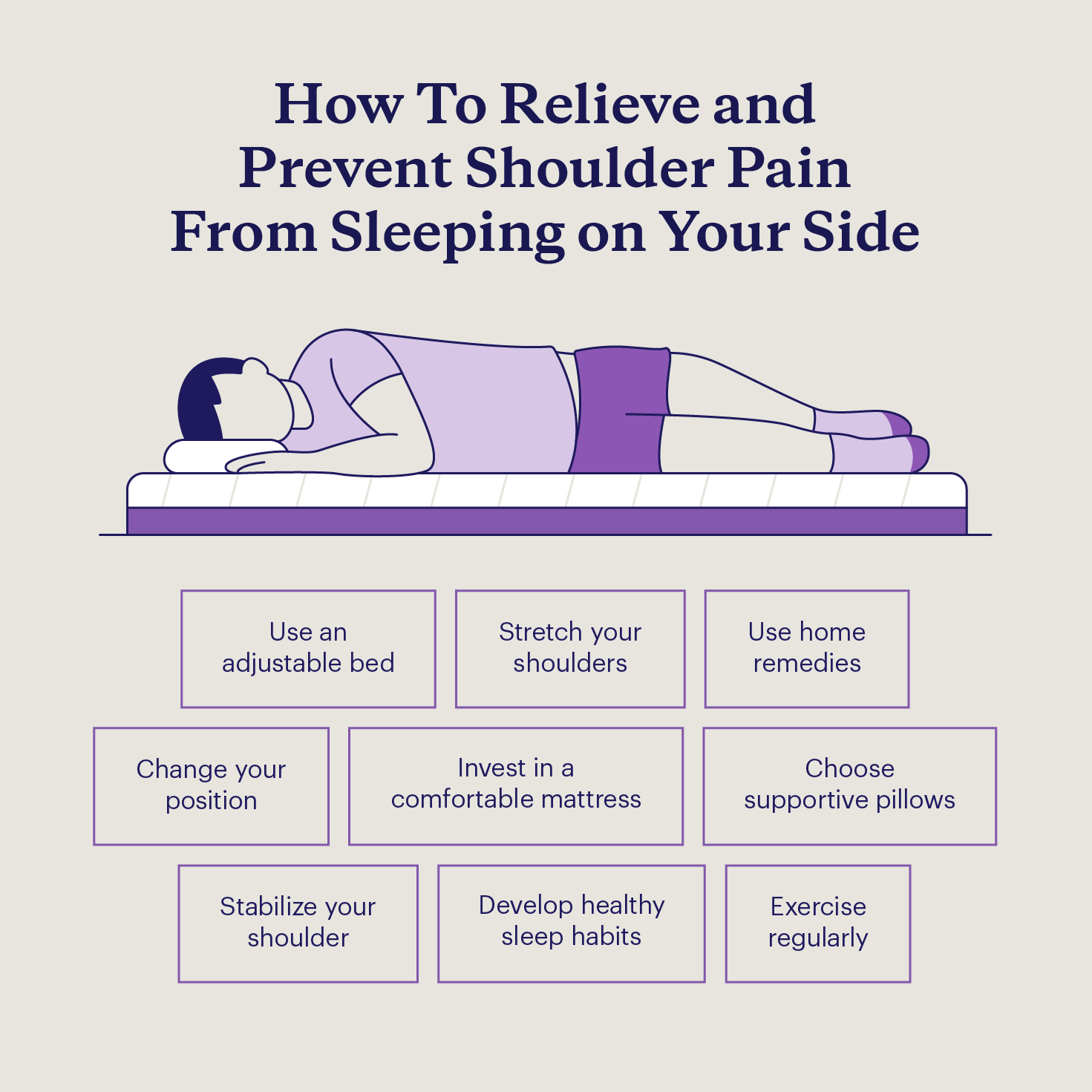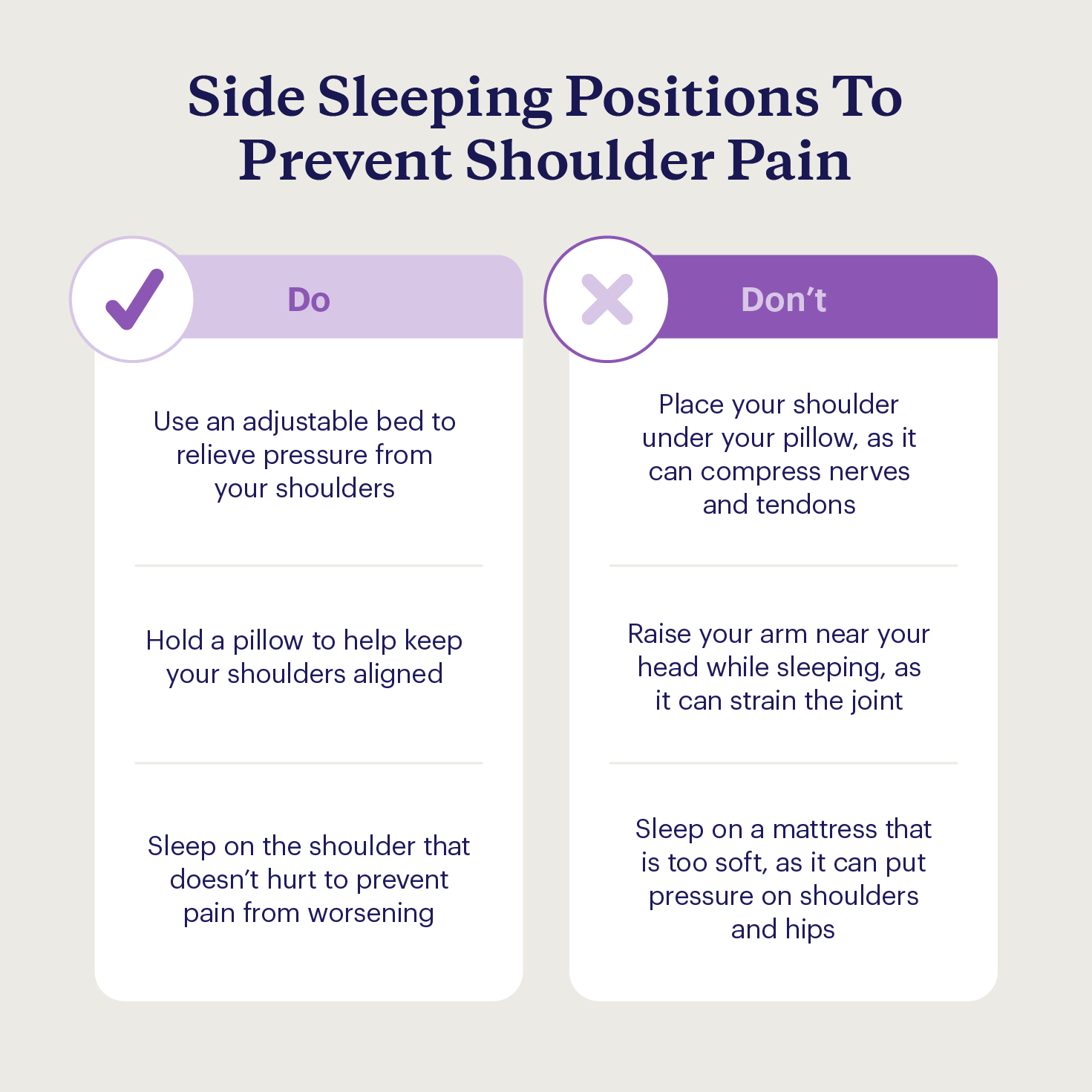
9 Solutions to Shoulder Pain From Sleeping on Your Side [Tips + Causes]
Key Takeaways
- The best way to reduce pain associated with side sleeping is to switch your position.
- Investing in a better mattress and pillows can provide the support you need to reduce shoulder and neck pain.
- Always seek medical attention if your pain is persistent.
Sleep is essential to your well-being. Waking up unrested and sore is not only an annoyance but also bad for your health. But, what are you supposed to do when it’s your preferred sleeping position that’s causing you pain?
If you’re a side sleeper, this may be a common occurrence for you. Fortunately, there are several solutions to shoulder pain from sleeping on your side — from stretches to investing in a more supportive mattress engineered for side sleepers. Keep reading to learn how you can wake up pain-free.
Read along to learn how you can reduce shoulder pain associated with sleeping on your side.
How To Sleep on Your Side Without Hurting Your Shoulder
There’s good and bad news if you’re a side sleeper experiencing shoulder pain.
The good news is that there are many different ways to remedy the pain you’re experiencing or eliminate it altogether. The bad news is that the number one way to get rid of the pain is by switching your sleeping position.
Side sleeping can cause shoulder and neck pain as well as exacerbate existing conditions, such as frozen shoulder, tendonitis, and arthritis. Let’s focus on the good news — here are the ways that you can improve your shoulder pain and sleep quality.
1. Change Your Sleep Position
If you want to know how to sleep on your side without hurting your shoulder, the best method is likely switching up your sleep position. For most people, sleeping on your back provides the most benefits, such as better support and improved breathing.
But if you’re determined to continue sleeping on your side, there are several ways to do so without causing continued pain. Here are some other methods of sleeping on your side that may help:
Sleep on Your Other Side
If one shoulder hurts but the other doesn’t, try switching to sleep on the shoulder that doesn’t hurt. Even just alternating between sides to avoid one shoulder experiencing too much pressure throughout the night can lessen the risk of pain.
Sleep on Your Back
While sleeping on your back may not come naturally to everyone, there are some ways to train yourself how to sleep on your back. This includes sleeping with pillows on your side to prevent yourself from rolling over, putting a pillow beneath your knees, or getting an adjustable bed.
Adjust Your Shoulder Placement
You should also be mindful of how you place your shoulder while sleeping. For example, sleeping with your arm under the pillow can cause shoulder pain, as well as sleeping with your arms above your head. Knowing how to properly sleep on a pillow, whether you are a side sleeper or not, can benefit your body and sleep quality.
2. Invest in a Comfortable Mattress
Some people experience both hip and shoulder pain from sleeping on their side, and the culprit may not just be the sleeping position but the mattress itself. The level of support the mattress provides, the material it’s made of, and even your type of bedding will all impact your level of comfort and quality of sleep.
Purple’s GelFlex® Grid offers support for all types of sleepers. The geometric structure provides both comfort and support, cradling your hips and shoulders no matter your sleep position. Experience the difference with Purple’s RestorePremier™ Hybrid mattress, which conforms to the body and provides ultimate pressure relief for sore joints.
3. Choose Supportive Pillows
Shoulder pain from pillows is also common. If your pillow is too soft or firm, or the loft is too high or low, it may cause neck and shoulder pain. Understanding the right firmness and ideal pillow height can improve sleep quality and lessen discomfort, as it prevents you from sinking too far into the mattress and overcompensating. You may also consider a pillow with an adjustable loft, such as the Purple Freeform™ Pillow.
Pillows can also offer great support if you experience hip pain from your mattress or sleep position. Sleep with a pillow, such as the Purple Harmony™ Anywhere Pillow, tucked between your knees to keep your hips aligned.
4. Use an Adjustable Bed
There are many benefits of an adjustable bed. First, keeping the head elevated can relieve shoulder pain for side sleepers. This works because it helps distribute pressure more evenly across the body.
Adjustable beds also help with snoring and sleep apnea, improve symptoms of chronic heartburn, and reduce back or other chronic pain.
5. Stretch Your Shoulders and Neck
Regular stretching before bed and when you wake up can help relieve neck and shoulder pain from sleeping on your side. Stretching is an important part of any day, whether you have a sedentary office job or a physically demanding labor job.
Here are some stretches to help with shoulder and neck pain:
- Doorway stretch: Using a door frame, rest your arms at a 90-degree angle cactus position. Standing with your feet shoulder-width apart, lean forward to stretch your chest and shoulders.
- Child’s pose: In a kneeling position with your bottom resting on your heels, fold your torso over your knees and bring your hands to the ground in front of you. Aim to rest your forehead on the ground. You should feel this stretch in your spine, hips, and shoulders.
- Shoulder rolls: As the name implies, bring your shoulders up toward your ears, rolling them backward and forward to stretch them out.
- Posterior capsule stretch: Pull your right arm across your chest and hold your elbow with your left hand, stretching out the shoulder. Repeat on the opposite side. This is also called a crossover arm stretch.
- Sleeper stretch: Start by lying down on your side on a hard flat surface, such as the floor, and reach your bottom arm out in front of your body, with the upper arm flat on the ground and your forearm at a 90-degree angle in front of you. Then, use the opposite hand to push your forearm toward the ground. Repeat on the opposite side.
As with any exercise, always stop if you experience pain or discomfort. Consult your healthcare provider if you have specific concerns or questions about stretches to help you.
6. Use Home Remedies
There are various home remedies you can try to help relieve shoulder pain, including:
- Icing or applying heat to the affected area
- Using NSAIDs (non-steroidal anti-inflammatory drugs) such as aspirin or ibuprofen
- Stretching or yoga
If the pain is persistent and you’ve tried several methods to remedy it without luck, consult a healthcare professional and listen to their advice about how to resolve the issue.
7. Stabilize Your Shoulder
Consider stabilizing your shoulder at night to provide shoulder support. This can include taping your shoulder using special kinesiology tape, which supports the shoulder and can help you sleep better. You can watch tutorials online for how to apply the tape or visit a physical therapist for advice.
You can also use a compression sleeve, which applies gentle pressure around the shoulder joint to help with inflammation and pain. Make sure you buy the correct size sleeve so it works properly.
8. Develop Good Sleep Habits
If it seems like no matter what you do, you’re still tossing and turning at night and waking up sore and poorly rested, you may need to change your sleep habits to get deeper sleep. While you may be sleeping through the night, if you’re not reaching your third stage of non-rapid eye movement (NREM) sleep, you may still wake up feeling unrested.
Here are some ways to develop better sleep habits:
- Create a bedtime routine that includes avoiding screen time, getting comfortable, and essentially reminding your body that it’s time to sleep.
- Limit caffeine, particularly later in the day.
- Limit light and sound in the bedroom with blackout curtains and a white noise machine.
- Cool your room to the ideal temperature for good sleep, which is generally between 60 and 70 degrees Fahrenheit.
9. Exercise Regularly
Exercise has many benefits. In general, regular exercise can improve overall quality of sleep, as it fatigues you and provides stress relief.
In particular, exercising your arms and shoulders can preventively help with the pain associated with sleeping on your side. It can also keep your neck and shoulders from getting stiff or numb overnight. Always speak with your healthcare provider about starting a new exercise regimen or seek the advice of a physical therapist for personalized recommendations.
Causes of Shoulder Pain From Sleeping on Your Side
While side sleeping itself is likely not the lone cause of shoulder pain, it can be a contributing factor, particularly if you have a pre-existing condition that may make you more prone to shoulder pain. Here are some common causes of shoulder pain:
- Impingement: Caused by repetitive motions, swelling, or bone abnormalities, shoulder impingement is when shoulder tendons rub against the nearby bone or tissue, causing pain and inflammation.
- Bursitis: Bursa are fluid-filled sacs around joints that can become inflamed, causing bursitis. This happens commonly in the shoulders, as well as hips, knees, and elbows.
- Rotator cuff tear: Often associated with repetitive motions and sports injuries, rotator cuff tears are quite common. They involve damage to the muscles and tendons around the shoulder joint.
- Osteoarthritis: The most common form of arthritis, osteoarthritis is when the cartilage around joints breaks down over time, causing pain, stiffness, and swelling.
- Tendonitis: Another common injury, tendonitis is the inflammation of the tendons around joints.
- Nerve entrapment: Nerve entrapment, or the squeezing of nerves by their surrounding tissues, such as bones, muscles, or tendons, is a painful condition that causes numbness, tingling, and weakness.
- Frozen shoulder: Also called adhesive capsulitis, frozen shoulder is the tightening of the shoulder joint, restricting movement and causing pain. The condition has no clear causes and can last up to three years before resolving on its own.
If you’re experiencing persistent pain in your shoulder or any unusual popping or crunching sounds, swelling, or the skin is warm to the touch, consult a medical professional. They can help narrow down the cause and offer a course of treatment to improve symptoms.
Sleep Better in Any Position With a Purple Mattress
While one of the best solutions to shoulder pain from sleeping on your side is to try to sleep in other positions, upgrading your mattress can also have a big impact.
If you’re tired of waking up with sore shoulders, tight hips, and a stiff neck, upgrade your mattress to Purple. Our GelFlex® Grid technology conforms to your body, providing the ideal amount of comfort and support, no matter your sleep position.
FAQ
Yes, continually sleeping on the same side every night without proper support may cause shoulder pain. However, there is usually an underlying cause, such as a medical condition or not enough support from your pillows or mattress.
Yes, side sleeping can be bad for your shoulders over prolonged periods. This is particularly true if you don’t have proper support.
Your shoulder may hurt when you sleep on your side due to the pressure it puts on the joint. Try using a pillow with a higher loft to better support your shoulders and neck.
Avoid neck and shoulder pain from sleeping on your side by sleeping with a pillow between your knees to better align your hips and shoulders or upgrading to a pillow for side sleepers to provide better support.
You can relieve neck and shoulder pain from sleeping on your side by stretching regularly, stabilizing your shoulder with a support sleeve, or using an NSAID like ibuprofen to manage the pain.
More To Explore
Level up your sleep routine with our most-loved products.










